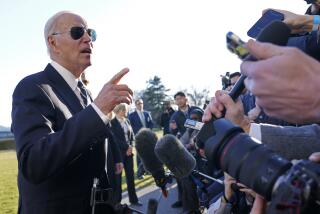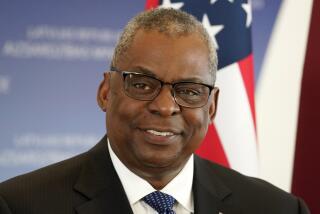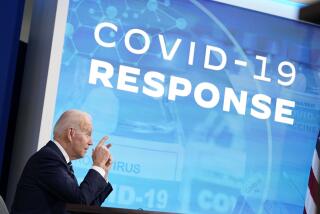Pentagon struggles as pandemic hits bases and ships
The Pentagon was waging a two-front war against the coronavirus outbreak Saturday, ramping up assistance in hard-hit states as commanders battled to prevent widespread infections in the ranks that could force them to curtail military operations around the globe.
The Pentagon already has canceled or reduced several large-scale training exercises, halted the movement of troops overseas and domestically, confined the aircraft carrier Theodore Roosevelt to port in Guam after an outbreak aboard the warship, and shuttered many of its recruiting offices around the country.
President Trump flew to Naval Station Norfolk in Virgina on Saturday to watch as the 1,000-bed Navy hospital ship Comfort departed for New York City, the epicenter of the U.S. outbreak, where it will take patients who don’t have the virus in an attempt to relieve overwhelmed civilian hospitals. The sister ship Mercy docked in the Port of Los Angeles on Friday to perform the same role there.
“We will win this war, and we will win this war quickly – with as little death as possible,” Trump said, standing on the pier with Defense Secretary Mark Esper.
The use of the two hospital ships highlighted the growing military role in assisting beleaguered state officials as they try to contain the contagion. As of Saturday, public health officials had confirmed more than 121,000 cases of COVID-19, the disease caused by the virus, and more than 2,000 deaths.
More than 12,000 members of the National Guard were mobilized as of Friday to help run testing sites, move supplies and build makeshift tent hospitals in dozens of states where infection numbers are rising and threatening to overwhelm civilian medical facilities.
At the same time, senior Pentagon officials and top commanders grappled with the potential effect on military operations and the potential risks to national security if thousands of U.S. military personnel become sick or need to be quarantined.
The Pentagon had tallied 613 coronavirus cases as of Friday among U.S. military personnel, family members, Defense Department civilians and contractors. More than half were uniformed military personnel, although a contractor and military dependent were the only reported deaths.
In South Korea, commanders on Friday for the first time ordered most of the 28,000 U.S. soldiers stationed there to remain in their barracks or off-post homes, hoping to curtail the spread of the virus. Only a bare-bones headquarters staff was on duty at Camp Humphreys, the main U.S. base south of Seoul, and other installations, a spokesman said.
“I think we will have moderate to low levels of readiness impacts, only because of the numbers — at least, the numbers so far,” Army Gen. Mark Milley, chairman of the Joint Chiefs of Staff, said in a video conference with military commands Tuesday. “This could change. We’ll have to assess it, and we are assessing it frequently… but I think it’ll be on the lower end.”
Senior Pentagon officials have issued a flurry of directives as they seek to preserve the readiness of U.S. forces and prevent the spread of the virus, especially among active duty troops.
Balancing health risks against national security missions, the Pentagon has ordered many of the 25,000 workers to work from home. But civilian officials so far have given wide discretion to the military services to decide whether to cancel training or shrink operations.
In some cases, commanders have scaled back training events, including one of the largest exercises in Europe since the Cold War. It was supposed to involve 25,000 troops, many coming from bases in the United States, but was cut to 6,000 troops already overseas.
But for the most part, commanders have held off halting major training and operations entirely.
“I trust our commanders and our senior enlisted personnel to do the right thing particular to your unit, to your situation, to your mission,” Esper said in the video conference Tuesday. “It’s up to the commanders and senior [noncommissioned officers] to make the right calls relevant to their situation to ensure that we protect our people while at the same time maintaining mission readiness.”
But some former Pentagon officials warned against delegating too much discretion to commanders.
“Even in the best of times, boot camps and other group training sites are known for routinely having problems with controlling infections,” said Kathleen Hicks, a former Pentagon official now at the Center for Strategic and International Studies, a Washington think tank. “Yet boot camps continue, as does mission-essential training, even as cases of infection come to light.”
As of Friday, governors in every state as well as Puerto Rico, Guam, the U.S. Virgin Islands and Washington, D.C., had activated Guard members to help civilian authorities respond to the virus outbreak, according to the National Guard Bureau, the Pentagon office that oversees the reservists.
Defense officials have sought to limit the mobilization to avoid taking doctors, nurses and other medical personnel who serve in the reserves from civilian hospitals and other jobs where they already may be treating infected patients.
The Pentagon has also tried to quash rumors fueled by Facebook and Twitter showing military equipment moving by rail and suggesting that activation of the Guard could lead to imposition of martial law to enforce quarantines and stay-at-home orders.
“There is no truth to this rumor that people are conspiring, that governors are planning, that anyone is conspiring to use the National Guard ... to do military action to enforce shelter in place or quarantines,” Gen. Joseph Lengyel, chief of the National Guard Bureau, told reporters in a conference call.
The Pentagon on Wednesday halted troop movements worldwide for 60 days, essentially freezing in place thousands of soldiers, airmen and others who were due to transfer from one assignment to another, as well as whole units that had been scheduled to deploy overseas.
The order allowed a planned troop drawdown to continue in Afghanistan, allowing a key Trump political goal — scaling down involvement in America’s longest war — to move ahead, even as the virus spreads.
Trump on Friday signed an order permitting the Pentagon to activate for up to two years as many as 1 million former service members from the ready reserves so they can assist in responding to the COVID-19 pandemic.
Officials said there are no plans now to bring back into service anything close to that number. But the order gives the military flexibility should additional medical personnel and other specialists be required.
More than 9,000 former soldiers expressed interest in returning to active duty after the Pentagon emailed 800,000 of them to gauge interest, according to the Army.
In a sign of the paralyzing uncertainty the virus is causing, the Army, the military’s largest branch, ordered a halt to all training exercises and nonessential activities last week but later rescinded the order after it sparked widespread confusion in the ranks.
Asked to comment on the canceled order, Lt. Col. Crystal Boring, an Army spokeswoman, said, “The Army is constantly assessing the current situation.” The order was first reported by the New York Times.
In South Korea, the stay-in-barracks orders forced cancellation of unit training and other daily operations.
But the top commander of U.S. forces in Korea said the move would not degrade the readiness of his forces, who are stationed on the Korean peninsula in order to deter North Korea. Pyongyang has launched several projectiles into the sea in recent weeks, including one reportedly on Saturday.
“We’re at a pretty high level of readiness, so I’m not concerned for four or five or six days. Now if we had to hypothetically maintain these conditions for 30 days, then I would start to get concerned,” Gen. Robert Abrams, the top U.S. commander in Korea, told Stars and Stripes, a Pentagon-funded newspaper that serves troops.
The U.S. and South Korea previously canceled joint military exercises planned for this month due to the pandemic.
Often forced to live in close quarters in far-flung parts of the globe, military personnel face unique risks from the easily-spread virus, experts said. Because most troops are relatively young, and are subject to strict regulations, the effect is likely to be more limited than in the civilian population.
Sailors aboard the aircraft carrier Roosevelt began getting sick after a port visit in Vietnam in early March. Three sailors who tested positive for the coronavirus two weeks after the ship departed Da Nang were flown off the ship for treatment.
But 36 infections were soon detected aboard the carrier, and after the Roosevelt reached Guam on Thursday in a previously scheduled port visit, the entire crew of 5,000 underwent testing.
The carrier will remain in Guam with the crew confined to the ship or the pier indefinitely, officials said.
“We are taking this threat very seriously and are working quickly to identify and isolate positive cases while preventing further spread of the virus aboard the ship,” Adm. Mike Gilday, chief of naval operations, said in a statement.
To guard against the virus affecting operations in Afghanistan, commanders are separating troops and putting newly arrived troops in quarantine, said Bruce Klingner, the father of a Marine serving in Afghanistan and a research fellow at the Heritage Foundation, a Washington think tank.
Klingner’s son was assigned new sleeping quarters, away from others in his own job classification, in order to lower the chances that all of them would become infected, Klingner said in a tweet Saturday. His son is a “joint terminal attack controller,” a Marine responsible for directing airstrikes from the ground.
“I’m sitting in my new room in the morgue,” Klingner’s son told his father in a video chat.
“You call it that because it was so quiet?” Klingner said he asked.
“No, because it was the morgue,” his son replied.
More to Read
Get the L.A. Times Politics newsletter
Deeply reported insights into legislation, politics and policy from Sacramento, Washington and beyond. In your inbox three times per week.
You may occasionally receive promotional content from the Los Angeles Times.







